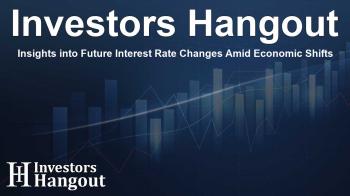Insights into Future Interest Rate Changes Amid Economic Shifts

Challenges Ahead for Interest Rate Reductions
By Howard Schneider
Federal Reserve officials have recently indicated that any further cuts to interest rates are currently paused. This cautious approach stems from a combination of slowed progress on inflation and the robust condition of the U.S. economy. As policymakers prepare for new dynamics in the economic landscape, there is heightened interest in the minutes from the central bank's past meetings.
After executing a quarter-point rate cut during their December meeting, Fed Chair Jerome Powell noted a prudent approach moving forward. Policymakers are now likening their decision-making process to "driving on a foggy night or walking into a dark room full of furniture," reflecting concerns about the anticipated impacts of various proposals from the incoming Trump administration.
Examining the December Meeting Minutes
The minutes from the December 17-18 meeting, set to be released, are expected to shed light on the prevalent sentiment among Fed officials regarding future rate adjustments. A key indicator from that gathering revealed expectations of a mere half percentage point in rate cuts for the coming year, a marked reduction from earlier expectations of a full percentage point.
Analysts from Citi predict that the upcoming minutes will clearly articulate a more hawkish viewpoint. This includes serious discussions around the potential for inflation to persist above the desired levels if interest rates do not remain sufficiently restrictive. The prevailing view may also indicate that the necessary interest rates to effectively bring inflation back to the Fed's 2% target may be trending higher.
Current Economic Indicators
Since the Fed's recent decisions, economic data has remained stable across several important sectors. For example, growth continues above the 2% threshold, with the unemployment rate hovering around the low 4% range. Furthermore, the preferred inflation measure of the Fed, known as the personal consumption expenditures price index, recorded its latest figure at 2.4%.
Moreover, public statements from Fed officials suggest that there is no immediate need to rush into further cuts. They are waiting for discernable shifts in employment trends or inflation rates to confirm any significant changes in economic trajectory.
Richmond Fed President Thomas Barkin recently emphasized the necessity of maintaining tight credit conditions until inflation demonstrates a reliable decrease towards the 2% target. He acknowledged that the demand side of the economy must also show substantial signs of weakness before considering any further cuts.
Labor Market Insights and Job Data
Upcoming job data reports are anticipated to provide vital insights into how employment figures and wages are evolving. A labor market survey released indicated a mixed picture, suggesting some areas of resilience alongside signs of a softening hiring environment. Slight increases in job openings suggest ongoing economic strength, yet decreases in hiring and voluntary quits hint at potential vulnerabilities.
Meanwhile, the minutes may reveal discussions among Fed officials regarding the timeline to halt the current strategy aimed at reducing the central bank's balance sheet. Having decreased their bond holdings significantly since the summer of 2022, there is speculation that this quantitative tightening effort may come to a close by 2025.
Looking Forward: What Lies Ahead?
In conclusion, the Fed is perched at a critical junction, evaluating a multitude of factors to determine the pace of interest rate changes. The released minutes are likely to give a clearer picture of policymakers' sentiment in this unpredictable economic climate, potentially guiding their strategies in the coming months.
Frequently Asked Questions
What factors are influencing the Fed's stance on interest rates?
The Fed's caution is influenced by slowed inflation progress and a stable U.S. economy, with officials wanting to avoid unnecessary rate cuts.
When will the Fed release the minutes from the December meeting?
The minutes are scheduled for release at 2 p.m. EST, and they are expected to clarify policymakers' views on future interest rate cuts.
What recent economic data could affect the Fed's decisions?
Upcoming job data and inflation readings will play crucial roles in guiding the Fed's future decisions on interest rate adjustments.
How might the new administration impact the Fed's policies?
Policy proposals from the incoming administration may introduce uncertainties that the Fed is now carefully considering in its decision-making process.
What is quantitative tightening, and when might it end?
Quantitative tightening involves reducing the central bank's balance sheet, and some expect this strategy may conclude around 2025, based on ongoing discussions.
About Investors Hangout
Investors Hangout is a leading online stock forum for financial discussion and learning, offering a wide range of free tools and resources. It draws in traders of all levels, who exchange market knowledge, investigate trading tactics, and keep an eye on industry developments in real time. Featuring financial articles, stock message boards, quotes, charts, company profiles, and live news updates. Through cooperative learning and a wealth of informational resources, it helps users from novices creating their first portfolios to experts honing their techniques. Join Investors Hangout today: https://investorshangout.com/
Disclaimer: The content of this article is solely for general informational purposes only; it does not represent legal, financial, or investment advice. Investors Hangout does not offer financial advice; the author is not a licensed financial advisor. Consult a qualified advisor before making any financial or investment decisions based on this article. The author's interpretation of publicly available data shapes the opinions presented here; as a result, they should not be taken as advice to purchase, sell, or hold any securities mentioned or any other investments. The author does not guarantee the accuracy, completeness, or timeliness of any material, providing it "as is." Information and market conditions may change; past performance is not indicative of future outcomes. If any of the material offered here is inaccurate, please contact us for corrections.
